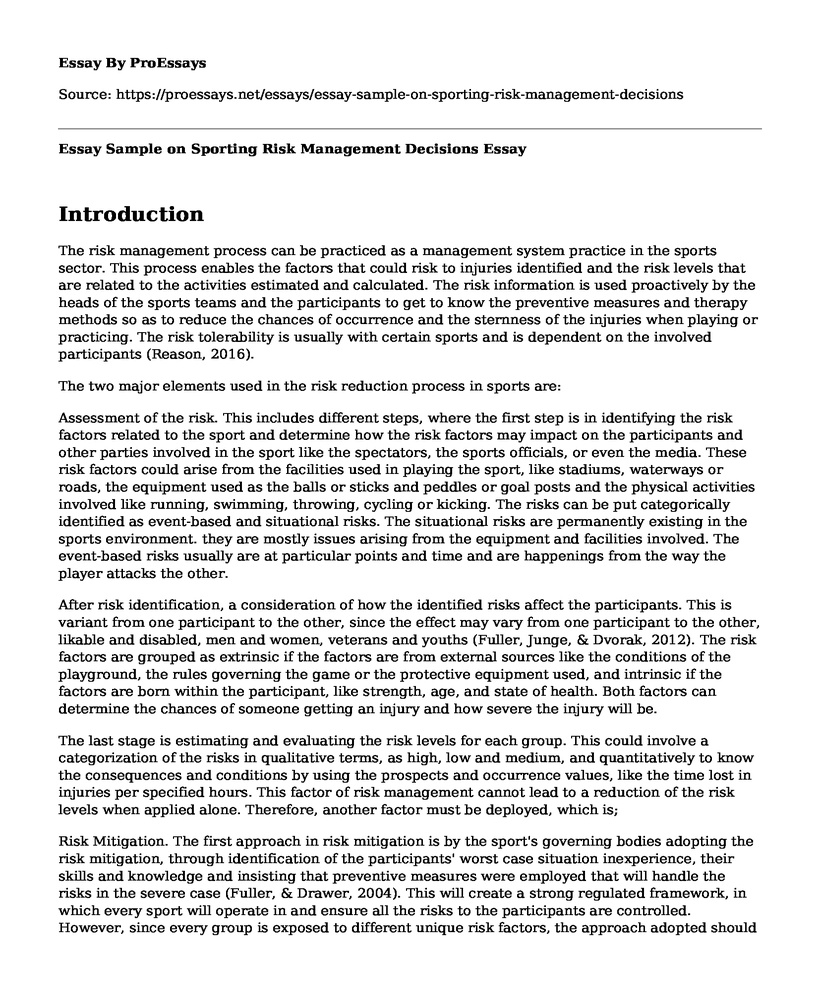Introduction
The risk management process can be practiced as a management system practice in the sports sector. This process enables the factors that could risk to injuries identified and the risk levels that are related to the activities estimated and calculated. The risk information is used proactively by the heads of the sports teams and the participants to get to know the preventive measures and therapy methods so as to reduce the chances of occurrence and the sternness of the injuries when playing or practicing. The risk tolerability is usually with certain sports and is dependent on the involved participants (Reason, 2016).
The two major elements used in the risk reduction process in sports are:
Assessment of the risk. This includes different steps, where the first step is in identifying the risk factors related to the sport and determine how the risk factors may impact on the participants and other parties involved in the sport like the spectators, the sports officials, or even the media. These risk factors could arise from the facilities used in playing the sport, like stadiums, waterways or roads, the equipment used as the balls or sticks and peddles or goal posts and the physical activities involved like running, swimming, throwing, cycling or kicking. The risks can be put categorically identified as event-based and situational risks. The situational risks are permanently existing in the sports environment. they are mostly issues arising from the equipment and facilities involved. The event-based risks usually are at particular points and time and are happenings from the way the player attacks the other.
After risk identification, a consideration of how the identified risks affect the participants. This is variant from one participant to the other, since the effect may vary from one participant to the other, likable and disabled, men and women, veterans and youths (Fuller, Junge, & Dvorak, 2012). The risk factors are grouped as extrinsic if the factors are from external sources like the conditions of the playground, the rules governing the game or the protective equipment used, and intrinsic if the factors are born within the participant, like strength, age, and state of health. Both factors can determine the chances of someone getting an injury and how severe the injury will be.
The last stage is estimating and evaluating the risk levels for each group. This could involve a categorization of the risks in qualitative terms, as high, low and medium, and quantitatively to know the consequences and conditions by using the prospects and occurrence values, like the time lost in injuries per specified hours. This factor of risk management cannot lead to a reduction of the risk levels when applied alone. Therefore, another factor must be deployed, which is;
Risk Mitigation. The first approach in risk mitigation is by the sport's governing bodies adopting the risk mitigation, through identification of the participants' worst case situation inexperience, their skills and knowledge and insisting that preventive measures were employed that will handle the risks in the severe case (Fuller, & Drawer, 2004). This will create a strong regulated framework, in which every sport will operate in and ensure all the risks to the participants are controlled. However, since every group is exposed to different unique risk factors, the approach adopted should recognize the presence of the definable groups, like veterans and youths, female and male and the abled and disabled, where special control processes are needed under different conditions. Under such condition, it will call for both general measures to control the general risks within a sports environment and specific control measures to prevent the unique risks associated with different groups of participants. Through this approach, big flexibility in the operation and addressing of specific needs of the participants is provided (O'Brien, et al., 2018).
References
Fuller, C. W., Junge, A., & Dvorak, J. (2012). Risk management: FIFA's approach to protecting the health of football players. Br J Sports Med, 46(1), 11-17.
Fuller, Colin & Drawer, Scott. (2004). The Application of Risk Management in Sport. Sports medicine (Auckland, N.Z.). 34. 349-56. 10.2165/00007256-200434060-00001.
O'Brien, James & Finch, Caroline & Pruna, Ricard & Mccall, Alan. (2018). A new model for injury prevention in team sports: The Team-sport Injury Prevention (TIP) cycle. Science and Medicine in Football. 1-4. 10.1080/24733938.2018.1512752.
The reason, J. (2016). Managing the risks of organizational accidents. Routledge. Retrieved from: https://doi.org/10.4324/9781315543543
Cite this page
Essay Sample on Sporting Risk Management Decisions. (2022, Dec 18). Retrieved from https://proessays.net/essays/essay-sample-on-sporting-risk-management-decisions
If you are the original author of this essay and no longer wish to have it published on the ProEssays website, please click below to request its removal:
- Future Nursing Recommendation Paper Example
- Vulnerability Management Development Paper Example
- Probiotics' Health Benefits Essay Example
- Article Analysis Essay on "The Syrian Humanitarian Disaster" and "A Crisis of Anxiety Among Aid Workers"
- Essay Sample on Congenital Heart Defects: Atrioventricular Canal
- Essay Example on Dental Radiography: Ensuring Safety and Understanding Risks
- Essay on the Biggest Issue Facing Healthcare: Inadequate Management & Its Consequences







